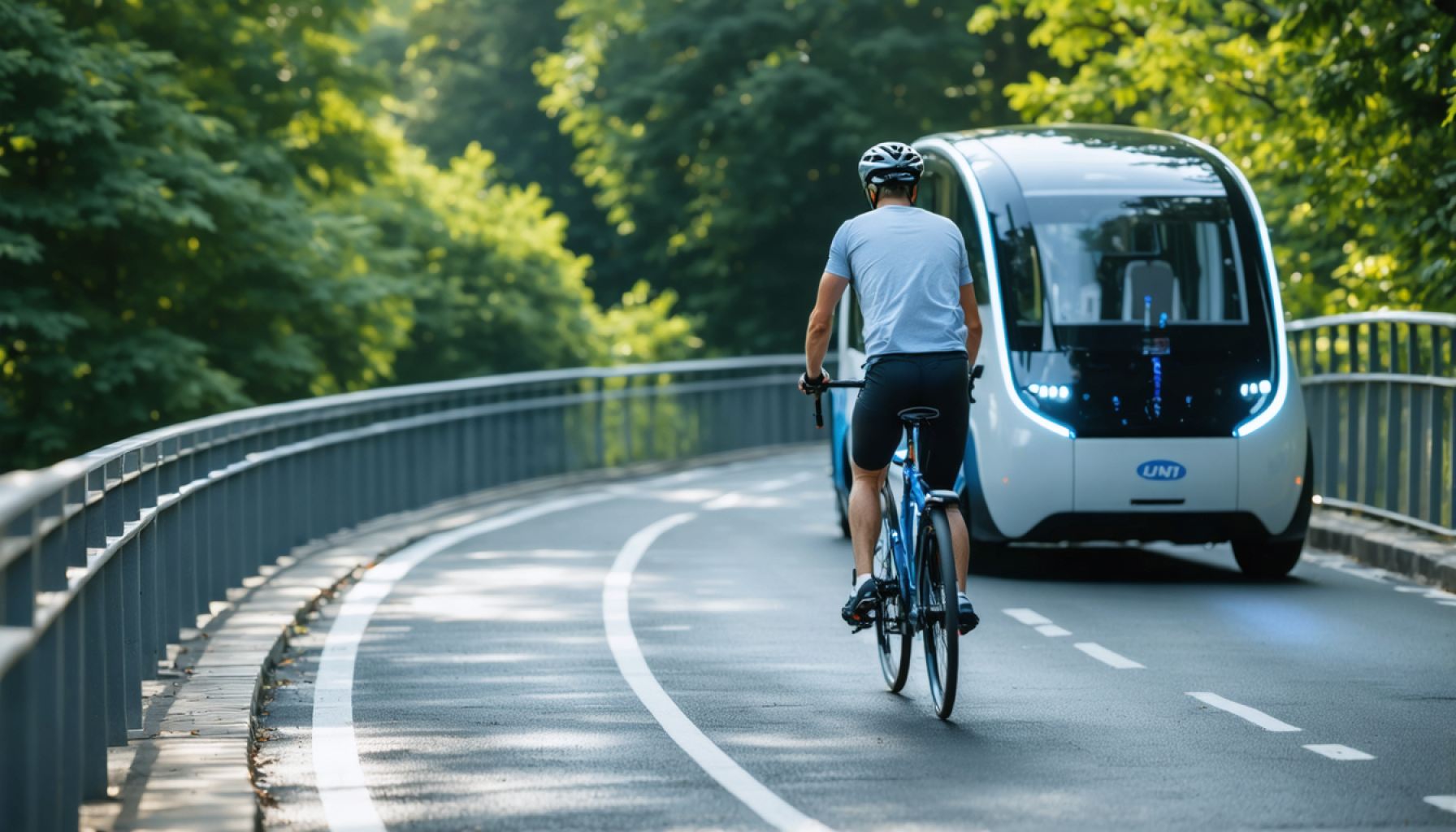
- CycleARcade is a transformative platform developed in Glasgow, aimed at improving interactions between cyclists and autonomous vehicles (AVs) using augmented reality (AR).
- The platform allows cyclists, equipped with AR headsets, to engage in a dual reality, enhancing their awareness of the intentions of nearby AVs.
- Key tools like RoadAlert and Gem communicate crucial warnings to cyclists, focusing on imminent threats without overwhelming them.
- The research emphasizes the need for AVs to adapt their communication styles based on cultural nuances and local infrastructure.
- The findings highlight the importance of empathy in technology, urging AV systems to understand and blend with human mobility patterns.
- CycleARcade’s insights are set to be presented at the CHI Conference in Japan, underscoring the crucial role of intuitive and innovative interactions in the future of transportation.
As dawn breaks over the sprawling cityscapes across the globe, a new era of transportation quietly edges closer. At its core lies a remarkable innovation, CycleARcade—a transformative platform rising from the vibrant halls of Glasgow’s School of Computing Science. Here, under the vision of Professor Stephen Brewster, technology is weaving a new tapestry of interaction between cyclists and the imminent tide of autonomous vehicles (AVs).
Imagine cycling through bustling streets framed by the delicate hues of the morning sun. With AR headsets perched like sentinels, cyclists are invited into a dual reality; one foot firmly planted in the world they know, the other venturing into a parallel universe where autonomous vehicles glide seamlessly beside them. It’s a world of augmented reality, where cyclists and AVs engage in a dance choreographed by cutting-edge research.
Inside this world, scenarios are pliable, shifting at the speed of thought. Cyclists don the CycleARcade headset and are immersed in an endless canvas of possibilities. Here, the team has meticulously crafted and tested various warning systems designed to communicate directly with cyclists—a crucial step towards forging a shared language between humans and machines. Under the watchful eye of researchers like Ammar Al-Taie, virtual interfaces such as RoadAlert and Gem emerge as tools, empowering cyclists with information about the intentions of nearby AVs.
The study revealed a vital nuance—cyclists don’t need to be alerted to all vehicles. Instead, CycleARcade sharply focuses attention where it matters most, safeguarding cyclists from imminent threats as they navigate real and virtual worlds intertwined. It’s a symphony of signals that echo the silent conversations shared by human drivers for generations.
The investigation deepened further, crossing borders into Sweden, Oman, and Scotland in pursuit of understanding cultural nuances. Here, CycleARcade revealed a tapestry of diverse cycling expectations, each unique thread shaped by local infrastructure and traditions. The findings highlighted the imperative for AVs to adapt their communication styles, tailoring their language to the rhythm of each country’s roads.
These insights, poised to make waves at the CHI Conference in Yokohama, Japan, underscore a pivotal truth. As autonomous vehicles prepare for their widespread debut, the challenge extends beyond engineering feats. It ventures into the realm of empathy—a need for technology to understand and assimilate into the vibrant mosaic of human mobility.
So, as the horizon ascends to a new dawn, CycleARcade stands as a beacon, illuminating a path towards harmony—a promise of safety and understanding on roads worldwide. In a world hurtling towards an autonomous tomorrow, it reminds us of the delicate dance between human intuition and technological innovation—a symbiotic relationship bound to shape the future of commuting.
The Future of Cycling: How CycleARcade is Bridging the Gap Between Cyclists and Autonomous Vehicles
As the world edges closer to a future dominated by autonomous vehicles, the safety and integration of all road users become paramount. The innovative CycleARcade platform aims to create a seamless interaction between cyclists and autonomous vehicles (AVs) by leveraging augmented reality (AR) to ensure both safety and communication on the roads.
Key Features and Technology
Augmented Reality (AR) Integration: The CycleARcade platform uses AR headsets to overlay critical information onto the cyclist’s real-world view. This allows for real-time communication of AV intentions, making every ride safer and more informed.
Advanced Warning Systems: Researchers have developed advanced warning systems such as RoadAlert and Gem, designed to offer cyclists clear, concise information about potential threats or movements from nearby AVs. These systems prioritize alerts, ensuring that cyclists are only informed of relevant dangers.
Cultural Sensitivity in Design: By studying cycling habits across countries like Sweden, Oman, and Scotland, CycleARcade is ensuring that their system adapts to local cycling norms and infrastructures, a necessity for global adoption.
How It Works
1. Installation and Setup: Cyclists equip themselves with an AR headset, which once set up, seamlessly connects to the CycleARcade network.
2. Real-Time Data Processing: As the cyclist navigates the cityscape, real-time data from road sensors and AVs is processed, determining potential interactions.
3. Alert System Activation: Personalized alerts are deployed to the cyclist, focusing on significant threats from AVs, thereby preventing information overload.
Real-World Use Cases
– Urban Commuters: City cyclists can navigate busy intersections with greater confidence, knowing that they will be alerted to any changes in AV proximity or trajectory.
– Tourism and Leisure: In tourist-heavy locales, CycleARcade can help new cyclists acclimate to local traffic patterns, reducing accidents and encouraging sustainable travel.
– Delivery Services: Couriers relying on bicycles can utilize this technology to minimize accidents, adhere to delivery deadlines, and maintain safety in rapidly changing street environments.
Pros & Cons Overview
Pros:
– Enhanced safety via real-time alerts.
– Reduced cognitive load by focusing only on imminent threats.
– Improved interaction between cyclists and AVs.
Cons:
– Initial cost and technology adoption barrier for users.
– Potential technical glitches in early trials.
– Dependence on AV infrastructure for optimal performance.
Market Forecast and Industry Trends
As cities around the world become increasingly congested and strive for greener transportation solutions, demand for technologies that ensure the safety of non-motorized road users is expected to grow. According to recent studies, the global market for AR technology in autonomous solutions is projected to reach billions of dollars within the next decade, showing significant potential for CycleARcade’s integration.
Actionable Recommendations
For cyclists and city planners looking to incorporate CycleARcade, consider the following:
– Start Small: Introduce AR systems in small pilot areas to gather user data and refine alert systems.
– Community Involvement: Engage local communities in testing to adapt the CycleARcade systems to meet regional needs.
– Collaborate with AV Companies: Partner with autonomous vehicle manufacturers to improve the symbiosis between CycleARcade and AV systems for both technological and regulatory advancements.
For more information on cutting-edge technology and innovation, visit the [University of Glasgow](https://www.gla.ac.uk) where CycleARcade was conceived. Here, ongoing research continues to push the boundaries of how we interact with tomorrow’s transportation technologies.



